2020高考全国卷阅读理解专项训练说明文六篇(生态环保类)(含答案)
2020年高考语文及答案解析(全国Ⅱ卷)

2020年普通高等学校招生全国统一考试语文本试卷共22题,共150分,共10页。
考试结束后,将本试卷和答题卡一并交回。
注意事项:1.答题前,考生先将自己的姓名、准考证号码填写清楚,将条形码准确粘贴在条形码区域内。
2.答题时请按要求用笔。
3.请按照题号顺序在答题卡各题目的答题区域内作答,超出答题区域书写的答案无效;在草稿纸、试卷上答题无效。
4.作图可先使用铅笔画出,确定后必须用黑色字迹的签字笔描黑。
5.保持卡面清洁,不要折叠、不要弄破、弄皱,不准使用涂改液、修正带、刮纸刀。
一、现代文阅读(36分)(一)论述类文本阅读(本题共3小题,9分)阅读下面的文字,完成1~3题。
杜甫之所以能有集大成之成就,是因为他有可以集大成之容量。
而其所以能有集大成之容量,最重要的因素,乃在于他生而禀有一种极为难得的健全才性——那就是他的博大、均衡与正常。
杜甫是一位感性与理性兼长并美的诗人,他一方面具有极大极强的感性,可以深入到他接触的任何事物,把握住他所欲攫取的事物之精华;另一方面又有着极清明周至的理性,足以脱出于一切事物的蒙蔽与局限,做到博观兼美而无所偏失。
这种优越的禀赋表现于他的诗中,第一点最可注意的成就,便是其汲取之博与途径之正。
就诗歌体式风格方面而言,古今长短各种诗歌他都能深入撷取尽得其长,而且不为一体所限,更能融会运用,开创变化,千汇万状而无所不工。
我们看他《戏为六绝句》之论诗,以及与当时诸大诗人,如李白、高适、岑参、王维、孟浩然等,酬赠怀念的诗篇中论诗的话,都可看到杜甫采择与欣赏的方面之广;而自其《饮中八仙歌》《曲江三章》《同谷七歌》等作中,则可见到他对各种诗体运用变化之神奇工妙;又如从《自京赴奉先县咏怀五百字》《北征》及“三吏”“三别”等五古之作中,可看到杜甫自汉魏五言古诗变化而出的一种新面貌。
就诗歌内容方面而言,杜甫更是无论妍媸巨细,悲欢忧喜,宇宙的一切人物情态,都能随物赋形,淋漓尽致地收罗笔下而无所不包,如写青莲居士之“飘然思不群”,写空谷佳人之“日暮倚修竹”;写丑拙则“袖露两肘”,写工丽则“燕子风斜”;写玉华宫之荒寂,予人以一片沉哀悲响;写洗兵马之欢忭,写出一片欣奋祝愿之情、其涵蕴之博与变化之多,都足以为其禀赋之博大、均衡与正常的证明。
2020高考英语环保时文阅读试题(6页)

2020高考英语环保时文阅读试题Passage1: Large ecosystems(生态系统), such as the Amazon rainforest, will collapse and disappear alarmingly quickly, once a crucial tipping point is reached, according to calculations based on real-world data.Writing in Nature Communications, researchers from Bangor University, Southampton University and the University of London, reveal the speed at which ecosystems of different sizes will disappear, once they have reached a point beyond which they collapse — transforming into an alternative ecosystem. For example, once the “point of no return” is reached, the Amazon rainforest could shift to a Savannah-type ecosystem with a mix of trees and grass within 50 years, according to the research. Some scientists argue that many ecosystems are currently teetering(摇晃)on the edge of a cliff, with the fires and destruction of both the Amazon and Australian rainforests.“Unfortunately, what our paper reveals is that humanity needs to prepare for changes far sooner than expected,” says joint lead author Dr Simon Willcock of Bangor University. “These rapid changes to the world’s largest and most typical ecosystems would impact the benefits which they provide us with, including everything from food and materials, to the oxygen and water we need for life.”Ecosystems made up of a number of interacting species, rather than those dominated by one single species, may be more stable and take longer to shift to alternative ecosystem states. “Theseexample, elephants are termed a “key stone” species as they have a disproportionately(不成比例地)large impact on the landscape — pushing over trees, but also dispersing(传播)seeds over large distances. The authors state that the loss of key stone species, such as this, would lead to a rapid and dramatic change in the landscape within our lifetime. “This is yet another strong argument to avoid degrading our planet’s ecosystems; we need to do more to conserve biodiversity,” says Dr Gregory Cooper, University of London.1.What is the phenomenon described in paragraph 2?A. Many ecosystems are in danger currently.B. Large ecosystems have reached a tipping point.C. A new ecosystem will appear in the Amazon forest.D. Ecosystems are changed mainly due to natural disasters.2. What is paragraph 3 mainly about?A. The benefits of large ecosystems.B. The ways to prepare for the changes.C. The introduction to typical ecosystems.D. The influences of ecosystems’ changes on humanity.3. Which of the following best explains “mitigate” in the last paragraph?A. Cause.B. Ease.C. Increase.D. Judge.4. Why does the author mention elephants in the passage?A. To prove the destructive power of elephants.C. To present the great influences of large animals.B. To explain the reason for the reducing grassland.D. To stress the importance of conserving biodiversity.单词学习1. savannah-type adj. 稀树草原型的2. tipping point 引爆点,爆发点3. teeter on the edge/brink of sth. 处在(灾难或危险)的边缘The hotel is teetering on the edge of bankruptcy. 这家旅馆正濒临破产。
2020-2021高考语文论述类文本阅读训练经典题目(含答案)(1)
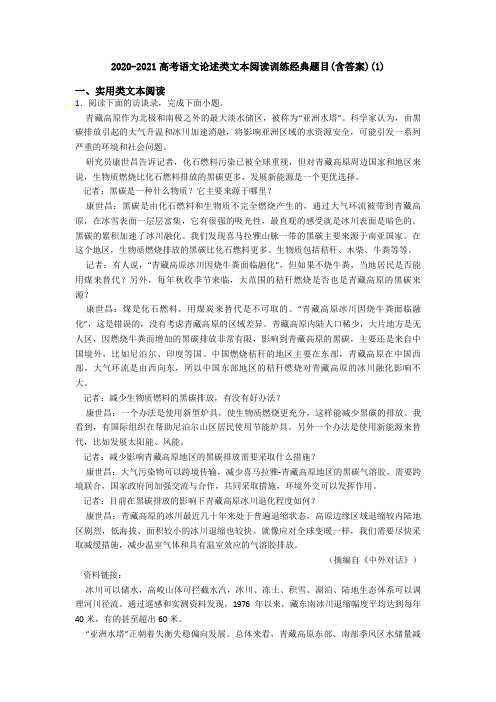
2020-2021高考语文论述类文本阅读训练经典题目(含答案)(1)一、实用类文本阅读1.阅读下面的访谈录,完成下面小题。
青藏高原作为北极和南极之外的最大淡水储区,被称为“亚洲水塔”。
科学家认为,由黑碳排放引起的大气升温和冰川加速消融,将影响亚洲区域的水资源安全,可能引发一系列严重的环境和社会问题。
研究员康世昌告诉记者,化石燃料污染已被全球重视,但对青藏高原周边国家和地区来说,生物质燃烧比化石燃料排放的黑碳更多,发展新能源是一个更优选择。
记者:黑碳是一种什么物质?它主要来源于哪里?康世昌:黑碳是由化石燃料和生物质不完全燃烧产生的,通过大气环流被带到青藏高原,在冰雪表面一层层富集,它有很强的吸光性,最直观的感受就是冰川表面是暗色的。
黑碳的累积加速了冰川融化。
我们发现喜马拉雅山脉一带的黑碳主要来源于南亚国家。
在这个地区,生物质燃烧排放的黑碳比化石燃料更多。
生物质包括秸秆、木柴、牛粪等等。
记者:有人说,“青藏高原冰川因烧牛粪面临融化”,但如果不烧牛粪,当地居民是否能用煤来替代?另外,每年秋收季节来临,大范围的秸秆燃烧是否也是青藏高原的黑碳来源?康世昌:煤是化石燃料,用煤炭来替代是不可取的。
“青藏高原冰川因烧牛粪面临融化”,这是错误的,没有考虑青藏高原的区域差异。
青藏高原内陆人口稀少,大片地方是无人区,因燃烧牛粪而增加的黑碳排放非常有限,影响到青藏高原的黑碳,主要还是来自中国境外,比如尼泊尔、印度等国。
中国燃烧秸秆的地区主要在东部,青藏高原在中国西部,大气环流是由西向东,所以中国东部地区的秸秆燃烧对青藏高原的冰川融化影响不大。
记者:减少生物质燃料的黑碳排放,有没有好办法?康世昌:一个办法是使用新型炉具,使生物质燃烧更充分,这样能减少黑碳的排放。
我看到,有国际组织在帮助尼泊尔山区居民使用节能炉具。
另外一个办法是使用新能源来替代,比如发展太阳能、风能。
记者:减少影响青藏高原地区的黑碳排放需要采取什么措施?康世昌:大气污染物可以跨境传输,减少喜马拉雅-青藏高原地区的黑碳气溶胶,需要跨境联合,国家政府间加强交流与合作,共同采取措施,环境外交可以发挥作用。
2020年普通高等学校招生全国统一考试语文试题(全国卷1,含答案)
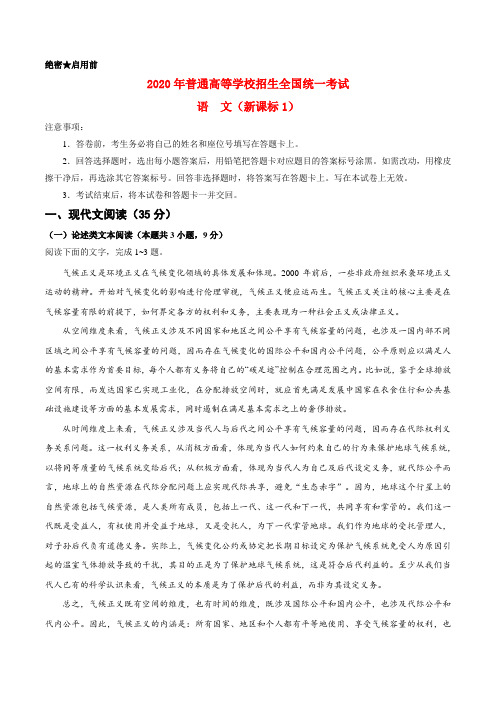
绝密★启用前2020年普通高等学校招生全国统一考试语文(新课标1)注意事项:1.答卷前,考生务必将自己的姓名和座位号填写在答题卡上。
2.回答选择题时,选出每小题答案后,用铅笔把答题卡对应题目的答案标号涂黑。
如需改动,用橡皮擦干净后,再选涂其它答案标号。
回答非选择题时,将答案写在答题卡上。
写在本试卷上无效。
3.考试结束后,将本试卷和答题卡一并交回。
一、现代文阅读(35分)(一)论述类文本阅读(本题共3小题,9分)阅读下面的文字,完成1~3题。
气候正义是环境正义在气候变化领域的具体发展和体现。
2000年前后,一些非政府组织承袭环境正义运动的精神。
开始对气候变化的影响进行伦理审视,气候正义便应运而生。
气候正义关注的核心主要是在气候容量有限的前提下,如何界定各方的权利和义务,主要表现为一种社会正义或法律正义。
从空间维度来看,气候正义涉及不同国家和地区之间公平享有气候容量的问题,也涉及一国内部不同区域之间公平享有气候容量的问题,因而存在气候变化的国际公平和国内公平问题,公平原则应以满足人的基本需求作为首要目标,每个人都有义务将自己的“碳足迹”控制在合理范围之内。
比如说,鉴于全球排放空间有限,而发达国家已实现工业化,在分配排放空间时,就应首先满足发展中国家在衣食住行和公共基础设施建设等方面的基本发展需求,同时遏制在满足基本需求之上的奢侈排放。
从时间维度上来看,气候正义涉及当代人与后代之间公平享有气候容量的问题,因而存在代际权利义务关系问题。
这一权利义务关系,从消极方面看,体现为当代人如何约束自己的行为来保护地球气候系统,以将同等质量的气候系统交给后代;从积极方面看,体现为当代人为自己及后代设定义务,就代际公平而言,地球上的自然资源在代际分配问题上应实现代际共享,避免“生态赤字”。
因为,地球这个行星上的自然资源包括气候资源,是人类所有成员,包括上一代、这一代和下一代,共同享有和掌管的。
我们这一代既是受益人,有权使用并受益于地球,又是受托人,为下一代掌管地球。
2020年普通高等学校招生全国统一考试[新高考全国卷Ⅰ]试题及答案解析
![2020年普通高等学校招生全国统一考试[新高考全国卷Ⅰ]试题及答案解析](https://img.taocdn.com/s3/m/14432faaf78a6529657d535c.png)
但是沿革地理并不等于历史地理学,二者不仅有量的不同,而且有质的区别。就研究内容而言,前者主要是疆域政区、地名和水道的变迁,后者却涉及地理学的各个分支。就研究的性质而言,前者一般只是对现象的描述和复原,很少涉及变化的原因,后者则不仅要复原各种以往的地理现象,而且要寻找它们变化发展的原因,探索背后的规律。由于产生于西方的现代地理学在中国的传播很迟,加上我国缺乏全面系统的科学基础,中国沿革地理虽然早已成为专门学问,却一直未形成新的学科。历史地理学则有自己独立的学科体系和理论,是现代地理学的一部分。
在这个城里,有个家的人真是有福啊。他们还能够像四百年前的祖先们那样安居乐业,不必操心左邻右舍的德行,都是世交啦。有一位绕过曲曲弯弯的小巷,提着在龙井市场买来的水淋淋的草芽(一种建水特有的水生植物,可食,滚油翻炒数秒起锅,甜脆)、莴笋、茄子、青椒、豆腐、毛豆、肉糜、茭瓜……一路上寻思着要怎么搭配,偶尔向世居于此的邻居熟人搭讪,彼此请安。磨磨蹭蹭到某个装饰着斗拱飞檐门头的大门前(两只找错了窝的燕子拍翅逃去),咯吱咯吱地推开安装着铜质狮头门环的双开核桃木大门,抬脚跨过门槛。绕过照壁,经过几秒钟的黑暗,忽然光明大放,回到了曾祖父建造的花香鸟语、阳光灿烂的天井。从供销社退休已经三十年的祖母正躺在一把支在天井中央的红木躺椅上,借着一棵百年香樟树的荫庇瞌睡呢。
成书于公元1世纪的《汉书·地理志》对见于典籍记载的重要地理要素,包括古国、历史政区、地名、河流、山岭、古迹等都做了记载和简要考证,并不局限于西汉一朝。作者班固比较充分地利用已有的地理记载和地理研究成果,使得中国历史地理学研究初具雏形。同样,成书于公元6世纪的《水经注》也从传世的数百种地理著作中搜集整理了大量史料,并做了深入的考证和研究。今天,我们之所以还能知道先秦的某一个地名在现在的什么地方,能知道秦汉以降的疆域范围,能够大致了解黄河早期的几次改道,都离不开这两种著作。
2020年 全国新高考Ⅱ卷 (含答案)

2020年全国统一考试试卷(新高考Ⅱ卷)语文一、现代文阅读(35分)(一)现代文阅读I(本题共5小题,17分)阅读下面的文字,完成1~5题。
巴巴看起来一点儿也不害怕。
它不怕把它团团围住的兴奋的小孩,而是十分镇定地接受着加州夏日烈阳的炙烤。
这种漫不经心的态度是能说得通的,因为它就生活在既安全又轻松的环境中。
巴巴是一只肚皮雪白的穿山甲,这种惹人喜爱的动物约莫一只小猫那么大。
它脸颊边缘的一圈毛好似山羊胡,粉色的脸颊下方是一截尖尖的、没有牙齿的口鼻——十分适合吸食蚂蚁和白蚁。
它最具特色的是覆满头、身、四肢和尾巴的鳞片,这些浅橙色的鳞片层层叠叠,形成了一件防御力极强的外套。
构成这些鳞片的成分和你的指甲一样,都是角蛋白。
巴巴是圣迭戈动物园的形象大使,它性格温顺,训练得当,能参与各类公众活动。
动物园的工作人员常常把巴巴带到福利院、儿童医院等地方,为患病的孩子带去快乐,并向他们普及关于各类珍稀动物的科学知识。
此时,罗布·奈特正用棉签轻轻擦拭它的脸部边缘,奈特是一名研究微观生命的学者,他研究细菌和其他微生物,特别着迷存在于动物体内或体表的微生物。
开展研究前,他首先得收集它们,收集蝴蝶的人会用网兜和罐子,奈特的工具则是棉签。
他把棉签伸进巴巴的鼻孔,仅仅转上几秒钟,就足以让白色棉签头上沾满来自穿山甲体内的微生物。
巴巴不仅是一只穿山甲,也是一个携带丰富微生物的聚合体:一些微生物生活在它的体内,绝大多数分布在肠道内,还有一些附着在它的脸部、肚子、爪子和鳞片表面。
其实人类身上也寄宿着微生物,地球上的所有生物都一样——唯一的例外,是科学家在实验室无菌环境下极其小心地培育出来的极少数动物。
我们身上仿佛在举办一场盛大的微生物展览,展品统称为微生物组。
它们生活在我们的皮肤表面、身体内部,甚至是细胞内部。
其中大部分是细菌,也有一些是其他的微小生命体,例如真菌(比如酵母菌)和古菌——后者的身份至今保持神秘,还有数量多到难以估量的病毒。
2020年普通高等学校招生全国统一语文考试及参考答案

2020年普通高等学校招生全国统一考试(全国卷Ⅰ)语文注意事项:1.答卷前,考生务必将自己的姓名、准考证号填写在答题卡上。
2.回答选择题时,选出每小题答案后,用铅笔把答题卡上对应题目的答案标号涂黑。
如需改动,用橡皮擦干净后,再选涂其他答案标号。
回答非选择题时,将答案写在答题卡上。
写在本试卷上无效。
3.考试结束后,将本试卷和答题卡一并交回。
一、现代文阅读(36分)(一)论述类文本阅读(本题共3小题,9分)阅读下面的文字,完成1~3题。
社会是由众多家庭组成的,家庭和谐关乎社会和谐。
要在家庭中建立一种和谐的关系,就需要有家庭伦理。
中国自古以来就有维护家庭关系的种种伦理规范,它们往往体现在各种“礼”之中。
从《礼记》中可以看到各种礼制的记载,如婚丧嫁娶,这些都包含着各种家庭伦理规范,而要使这些规范成为一种社会遵守的伦理,就要使“礼”制度化。
在中国古代,“孝”无疑是家庭伦理中最重要的观念。
《孝经》中有孔子的一段话:“夫孝,天之经也,地之义也,民之行也。
”这是说“孝”是“天道”常规,是“地道”通则,是人们遵之而行的规矩。
为什么“孝”有这样大的意义?这与中国古代宗法制有关。
中国古代社会基本上是宗法性的农耕社会,家庭不仅是生活单位,而且是生产单位。
要较好地维护家庭中长幼尊卑的秩序,使家族得以顺利延续,必须有一套维护当时社会稳定的家庭伦理规范。
这种伦理规范又必须是一套自天子至庶人都遵守的伦理规范,这样社会才得以稳定。
“孝”成为一种家庭伦理规范,并进而成为社会的伦理制度,必有其哲理上的根据。
《郭店楚简·成之闻之》中说:“天登大常,以理人伦,制为君臣之义,作为父子之亲,分为夫妇之辩。
”理顺君臣、父子、夫妇的关系是“天道”的要求。
君子以“天道”常规处理君臣、父子、夫妇伦理关系,社会才能治理好。
所以,“人道”与“天道”是息息相关的。
“孝”作为一种家庭伦理的哲理根据就是孔子的“仁学”。
以“亲亲”(爱自己的亲人)为基点,扩大到“仁民”,以及于“爱物”。
说明文阅读附答案10篇
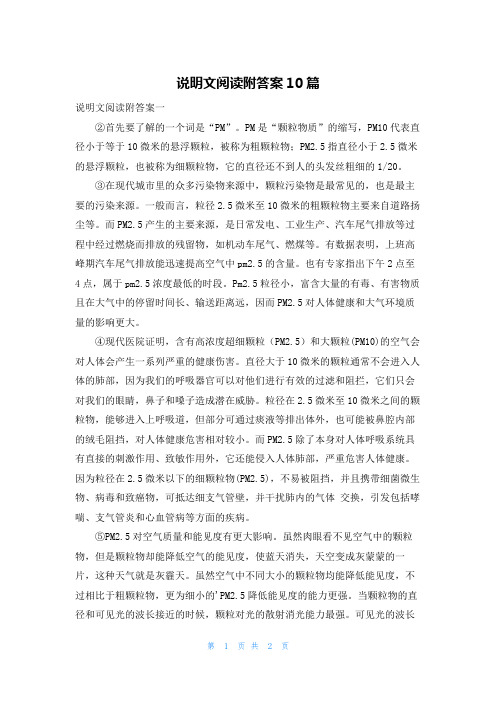
说明文阅读附答案10篇说明文阅读附答案一②首先要了解的一个词是“PM”。
PM是“颗粒物质”的缩写,PM10代表直径小于等于10微米的悬浮颗粒,被称为粗颗粒物;PM2.5指直径小于2.5微米的悬浮颗粒,也被称为细颗粒物,它的直径还不到人的头发丝粗细的1/20。
③在现代城市里的众多污染物来源中,颗粒污染物是最常见的,也是最主要的污染来源。
一般而言,粒径2.5微米至10微米的粗颗粒物主要来自道路扬尘等。
而PM2.5产生的主要来源,是日常发电、工业生产、汽车尾气排放等过程中经过燃烧而排放的残留物,如机动车尾气、燃煤等。
有数据表明,上班高峰期汽车尾气排放能迅速提高空气中pm2.5的含量。
也有专家指出下午2点至4点,属于pm2.5浓度最低的时段。
Pm2.5粒径小,富含大量的有毒、有害物质且在大气中的停留时间长、输送距离远,因而PM2.5对人体健康和大气环境质量的影响更大。
④现代医院证明,含有高浓度超细颗粒(PM2.5)和大颗粒(PM10)的空气会对人体会产生一系列严重的健康伤害。
直径大于10微米的颗粒通常不会进入人体的肺部,因为我们的呼吸器官可以对他们进行有效的过滤和阻拦,它们只会对我们的眼睛,鼻子和嗓子造成潜在威胁。
粒径在2.5微米至10微米之间的颗粒物,能够进入上呼吸道,但部分可通过痰液等排出体外,也可能被鼻腔内部的绒毛阻挡,对人体健康危害相对较小。
而PM2.5除了本身对人体呼吸系统具有直接的刺激作用、致敏作用外,它还能侵入人体肺部,严重危害人体健康。
因为粒径在2.5微米以下的细颗粒物(PM2.5),不易被阻挡,并且携带细菌微生物、病毒和致癌物,可抵达细支气管壁,并干扰肺内的气体交换,引发包括哮喘、支气管炎和心血管病等方面的疾病。
⑤PM2.5对空气质量和能见度有更大影响。
虽然肉眼看不见空气中的颗粒物,但是颗粒物却能降低空气的能见度,使蓝天消失,天空变成灰蒙蒙的一片,这种天气就是灰霾天。
虽然空气中不同大小的颗粒物均能降低能见度,不过相比于粗颗粒物,更为细小的'PM2.5降低能见度的能力更强。
说明文阅读题及答案2020整理归纳
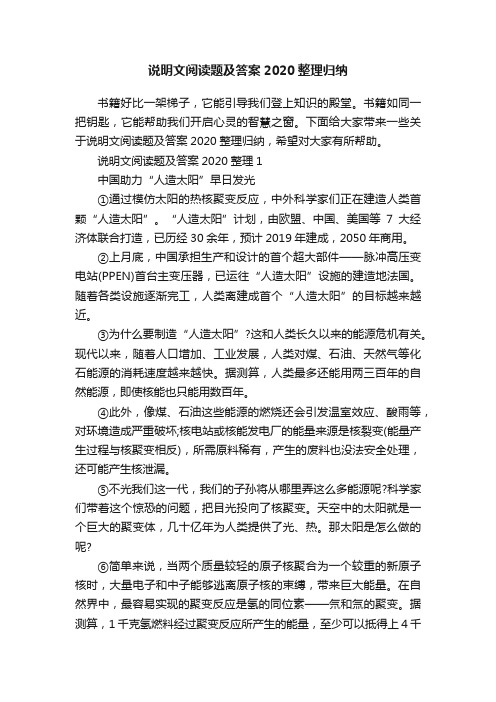
说明文阅读题及答案2020整理归纳书籍好比一架梯子,它能引导我们登上知识的殿堂。
书籍如同一把钥匙,它能帮助我们开启心灵的智慧之窗。
下面给大家带来一些关于说明文阅读题及答案2020整理归纳,希望对大家有所帮助。
说明文阅读题及答案2020整理1中国助力“人造太阳”早日发光①通过模仿太阳的热核聚变反应,中外科学家们正在建造人类首颗“人造太阳”。
“人造太阳”计划,由欧盟、中国、美国等7大经济体联合打造,已历经30余年,预计2019年建成,2050年商用。
②上月底,中国承担生产和设计的首个超大部件——脉冲高压变电站(PPEN)首台主变压器,已运往“人造太阳”设施的建造地法国。
随着各类设施逐渐完工,人类离建成首个“人造太阳”的目标越来越近。
③为什么要制造“人造太阳”?这和人类长久以来的能源危机有关。
现代以来,随着人口增加、工业发展,人类对煤、石油、天然气等化石能源的消耗速度越来越快。
据测算,人类最多还能用两三百年的自然能源,即使核能也只能用数百年。
④此外,像煤、石油这些能源的燃烧还会引发温室效应、酸雨等,对环境造成严重破坏;核电站或核能发电厂的能量来源是核裂变(能量产生过程与核聚变相反),所需原料稀有,产生的废料也没法安全处理,还可能产生核泄漏。
⑤不光我们这一代,我们的子孙将从哪里弄这么多能源呢?科学家们带着这个惊恐的问题,把目光投向了核聚变。
天空中的太阳就是一个巨大的聚变体,几十亿年为人类提供了光、热。
那太阳是怎么做的呢?⑥简单来说,当两个质量较轻的原子核聚合为一个较重的新原子核时,大量电子和中子能够逃离原子核的束缚,带来巨大能量。
在自然界中,最容易实现的聚变反应是氢的同位素——氘和氚的聚变。
据测算,1千克氢燃料经过聚变反应所产生的能量,至少可以抵得上4千克铀燃料或1000万千克优质煤燃料释放的能量。
⑦要提取它们,方法也十分简便,成本也很低。
我们从海水里舀一升水,其中就含有0.03克氘,它就可以产出约300公升汽油这么大的能量。
2020最新说明文阅读理解及答案

2020最新说明文阅读理解及答案甲醇汽车来了①近日,工信部等八部门联合发布了《关于在部分地区开展甲醇汽车应用的指导意见》,标志着我国甲醇汽车将逐步走进人們的生活。
②甲醇,这种无色透明易挥发的液体化学物质,既是一种基本的化工原料,又是一种很有吸引力的替代清洁燃料。
甲醇汽车就是甲醇应用于车用燃料的一个方向。
③甲醇来自哪里?甲醇原本就存在于自然环境中,是通过多种细菌的厌氧代谢自然产生的。
人类何时发现和利用甲醇已无法考证,但最初分离出纯净甲醇的是英国人罗伯特·波义耳。
波义耳是近代化学的开创者。
他于1661年从干馏黄杨木中分离获得了甲醇,因此,甲醇又被称为“木醇”或“木精”。
这也是工业上制取甲醇的最古老的方法。
1834年,法国化学家杜马和皮里哥分析了甲醇的元素构成,并确定其化学组成为CH3OH。
1905年,法国化学家萨巴蒂尔首先提出由合成气,即一氧化碳和氢气的混合物合成甲醇的观点。
1913年,艾尼林和法布里克提出了从煤炭合成气中合成甲醇,开启了煤制甲醇的历史。
1923年,德国建成世界上第一座年产3000吨的高压合成甲醇装置。
目前,世界上的甲醇生产大多采用低压工艺。
生产甲醇的合成气来源十分广泛,包括煤炭、天然气、焦炉气、煤层气等。
根据我国“富煤缺油少气”的国情,采用煤基甲醇的原料技术路线,利用低质煤、煤层气、焦炉煤气等制备甲醇,可以充分发挥我国煤炭资源的优势。
④何为甲醇汽车?甲醇汽车并不是指只能烧甲醇的汽车,而是以甲醇作为主要燃料,也可以烧汽油或者甲醇与汽油混合燃料的汽车。
甲醇在汽车上的应用主要有掺烧和纯甲醇替代两种方式。
所谓掺烧,是指把甲醇添加在汽油里并用甲醇燃料助溶剂复配的甲醇汽油混合燃料,使用低比例甲醇的甲醇汽油混合燃料,无须对发动机和装置进行改造就能直接使用。
使用高比例的甲醇汽油混合燃料,由于受到甲醇燃烧特性的限制,需要对发动机进行改造才能使用。
甲醇混合燃料具有良好的热效率、动力性、启动性和经济性,并具有节能环保等优势。
2020年全国普通高考浙江卷语文试题及答案解析
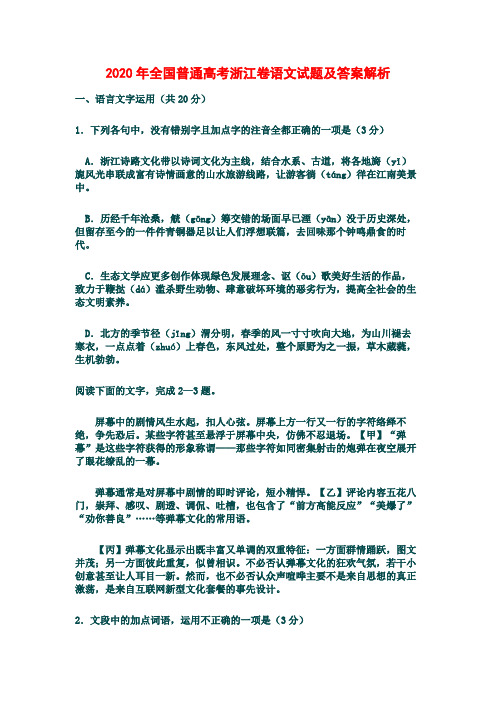
2020年全国普通高考浙江卷语文试题及答案解析一、语言文字运用(共20分)1.下列各句中,没有错别字且加点字的注音全都正确的一项是(3分)A.浙江诗路文化带以诗词文化为主线,结合水系、古道,将各地旖(yǐ)旎风光串联成富有诗情画意的山水旅游线路,让游客徜(táng)徉在江南美景中。
B.历经千年沧桑,觥(gōng)筹交错的场面早已湮(yān)没于历史深处,但留存至今的一件件青铜器足以让人们浮想联篇,去回味那个钟鸣鼎食的时代。
C.生态文学应更多创作体现绿色发展理念、讴(ōu)歌美好生活的作品,致力于鞭挞(dá)滥杀野生动物、肆意破坏环境的恶劣行为,提高全社会的生态文明素养。
D.北方的季节径(jīng)渭分明,春季的风一寸寸吹向大地,为山川褪去寒衣,一点点着(zhuó)上春色,东风过处,整个原野为之一振,草木葳蕤,生机勃勃。
阅读下面的文字,完成2—3题。
屏幕中的剧情风生水起,扣人心弦。
屏幕上方一行又一行的字符络绎不绝,争先恐后。
某些字符甚至悬浮于屏幕中央,仿佛不忍退场。
【甲】“弹幕”是这些字符获得的形象称谓——那些字符如同密集射击的炮弹在夜空展开了眼花缭乱的一幕。
弹幕通常是对屏幕中剧情的即时评论,短小精悍。
【乙】评论内容五花八门,崇拜、感叹、剧透、调侃、吐槽,也包含了“前方高能反应”“美爆了”“劝你善良”……等弹幕文化的常用语。
【丙】弹幕文化显示出既丰富又单调的双重特征:一方面群情踊跃,图文并茂;另一方面彼此重复,似曾相识。
不必否认弹幕文化的狂欢气氛,若干小创意甚至让人耳目一新。
然而,也不必否认众声喧哗主要不是来自思想的真正激荡,是来自互联网新型文化套餐的事先设计。
2.文段中的加点词语,运用不正确的一项是(3分)A.风生水起 B.短小精悍 C.然而 D.激荡3.文段中画线的甲、乙、丙句,标点有误的一项是(2分)A.甲 B.乙 C.丙4.下列各句中,没有语病的一项是()。
(3分)A.新冠肺炎疫情来势汹汹,严重威胁全人类的健康与福祉,也暴露了全球公共卫生治理上的短板,推进全球公共卫生治理体系改革的必要性。
2020年高考语文新课标全国1卷(详细答案分析版)

2020年高考语文新课标全国1卷(详细答案分析版)必考题一、现代文阅读(9分,毎小题3分)阅读下面的文字,完成1-3题宋代的农业、手工业、商业在唐代的基础上又有了新的发展,特别是商品经济出现了空前的繁荣。
在此背景下,宋代的货币流通和信用进入迅速发展时期,开创了古代金融的新篇章。
宋代在信用形式和信用工具方面都呈现出新的特点。
信用形式有借贷、质、押、典、赊买赊卖等多种形式。
借贷分为政府借贷和私人借贷。
政府借贷主要表现为赈贷的形式,在紧急情况下通过贷给百姓粮食或种子的方式,帮助他们度过困境。
私人借贷多为高利贷,它可以解决社会分化和“钱荒”带来的平民百姓资金严重不足的问题,满足特殊支付和燃眉之急的需要。
质、押是借贷的担保形式,由质库、解库等机构经营。
质属于动产担保,它必须转移动产的占有;押属于不动产担保,通常将抵押物的契约交付债权人即可。
债务人违约时,债权人可用变卖价款优先受偿。
典作为不动产转移的一种形式是在宋代形成和发展起来的。
其特点是典权人向出典人支付典价后,在典期内就占有了出典人典产的使用权和收益支配权,出典人也不必向典权人支付利息。
宋代的商业贸易非常发达,但存在着通货紧缩现象,故赊买赊卖行为也很普遍,几乎生产、流通、消费领域的所有物品都能进行赊买赊卖。
从实际效果看,它解决了军需、加强了流通,更重要的一点,它对束缚生产流通扩大和发展的高利贷构成了冲击。
随着社会经济的发展,宋代商业贸易对货币的要求越来越高,但是社会中货币供给和流通状况不尽理想,表现为货币流通区域的割据性、货币供给数量的有限性,以及大量流通的钢铁钱细碎和不便携带的特性,其结果是抑制了经济发展。
为了解决这类问题,在高度发达的纸币和印刷技术保障下,通过民间自发力量的作用和官府的强制推行,宋代社会陆续出现了诸如茶引、盐引、交子、关子和会子等新型纸质信用工具。
茶引、盐引要求相关人员先用粮草或现钱的付出作为取得的条件,然后凭此类纸质信用工具异地兑取现钱或政府专卖货物。
2020年普通高等学校招生全国统一考试语文试题(江苏卷,含答案)

2020年普通高等学校招生全国统一考试语文试题(江苏卷,含答案)一、语言文字运用(15分)1.下列加点的字,每对读音都不相同的一组是(3分)A.弹.劾/弹.丸之地哽咽./狼吞虎咽.责难./多难.兴邦B.鲜.活/寡廉鲜.耻泊.位/淡泊.明志叶.韵/一叶.知秋C.大度./审时度.势长.进/身无长.物解.救/浑身解.数D.参.差/扪参.历井披靡./风靡.一时畜.牧/六畜.兴旺【答案】C【解析】A.弹劾(tán) 弹丸之地(dàn) ,哽咽(gěng) 狼吞虎咽(yàn ), 责难(nàn)多难兴邦(nàn)。
B.鲜活(xiān)寡廉鲜耻(xiǎn),泊位(bó)淡泊明志(bó),叶韵(xié)一叶知秋(yè )。
C.大度(dù)审时度势(duó),长进(zhǎng)身无长物(cháng), 解救(jiě)浑身解数(xiè)。
D.参差(cēn)扪参历井(shēn),披靡(mǐ)风靡一时(mǐ),畜牧(xù)六畜兴旺(chù)2.下列各句中,加点的成语使用恰当的一句是(3分)A.司机张师傅冒着生命危险解救乘客的事迹,一经新闻媒体报道,就被传得满城风雨....,感动了无数市民。
B.近年来,在种种灾害面前,各级政府防患未然....,及时启动应急预案,力争把人民的生命财产损失将到最低限度。
C.这些“环保老人”利用晨练的机会,但游客丢弃在景点的垃圾信手拈来....,集中带到山下,分类处理。
D.“生命的价值在于厚度而不在于长度,在于奉献而不在于获取……院士的一番话入木三分....,让我们深受教育。
【答案】D【解析】A.满城风雨:城里到处刮风下雨。
原形容重阳节前的雨景。
后比喻某一事件传播很广,到处议论纷纷。
误在贬词褒用。
B.防患未然:防止事故或祸害于尚未发生之前。
与已然语境相违。
高考语文阅读理解《生态系统》含答案

高考语文阅读理解《生态系统》含答案(2022·广东·高三统考学业考试)阅读下面的文字,完成下面小题。
生态系统是地球表层的重要组成部分,又是人类生存和发展的物质基础。
全球变暖引起的生态系统结构和功能的变化,对自然和人类社会都将带来深刻的影响。
因此,研究并预测全球变暖所产生的生态影响以及生态系统对它的响应,成为全球变化研究的重大科学问题之一。
作为生态系统生产者的植物,其组成和生长发育对全球变化表现得十分敏感。
许多观测和研究已经证实,一方面,在全球变暖的作用下,植物个体形态首先发生明显的变化,特别在极地等一些对全球变化响应敏感的地区表现得更为显著,如随着温度升高,苔原植物的枝条显著变长,且叶片增大。
全球变暖对物种的生长发育过程会起到一定程度的促进作用。
其中,最为显著的影响就是物候的变化:随着气温的升高,植物春季物候期提前,秋季物候期推迟,导致植物的生长季延长。
这一过程可能有利于植物生长量的积累,但物候的提前也会使得植物提前开花放叶,这对某些植物(如早春的林下植物)完成生命周期可能产生不利的影响。
另一方面,全球变暖显著影响物种的分布,不少地区物种分布的“暖化”现象就是明显的证据。
譬如,对欧洲山地的研究发现,不同物种的数量有所变化,适应温暖环境的物种增加,而适应低温环境的物种显著减少。
此外,随着全球变暖,很多动植物向高海拔和高纬度迁移。
例如,20世纪以来,欧洲西部山脉发生了植物物种集中向山顶迁移的现象,每年的平均速度达3m;在英国、美国及芬兰等地发现鸟类大量向北方迁移,其北扩幅度在20年内可高达70km。
全球变暖对生态系统组成的影响——例如通过改变物种的生长发育过程和分布,会导致生态系统的物种组成和结构发生显著变化,最终可能改变一个地区的生态系统类型,引起生态系统功能的变化。
温度升高和干旱的加剧,更有利于喜温、耐旱植物的扩散和入侵;而一些极端气候事件(旱灾、霜冻、雪灾、洪涝、飓风等)的发生则会造成本地物种的快速死亡,从而增加外来物种入侵的风险。
高考说明文阅读练习附答案

高考说明文阅读练习附答案高考说明文阅读练习原文1:①鸡为什么要叫?这个问题看上去显然比不上“鸡为什么要过马路”那样充满哲思。
不过如果拿这个问题问保罗·西格尔,他可能会给出你并不少于“鸡为什么要过马路”的理由来。
西格尔是研究鸡的博士,他听得懂鸡的语言。
虽然对于大多数人,鸡的语言无非就是母鸡下蛋“咯咯哒”和公鸡打鸣“咯咯咯”,但是西格尔博士大概能听懂30种不同的“鸡话”。
这一点儿也不奇怪,鸡是一种社会性动物,一夫多妻的它们总有一大堆家庭琐事要处理。
特别是作为家长的公鸡,更是要担负很多指挥和决策任务。
②至于公鸡打鸣,鸡语专家告诉我们,那是一种“主权宣告”,一方面提醒家庭成员它至高无上的地位,另一方面警告邻近的公鸡不要打它家眷的主意。
美国新墨西哥大学的佛洛等人就曾尝试解码公鸡的打鸣声。
他们的研究不太像是在做生物学实验,反而是像给明星灌唱片。
佛洛他们动用了高灵敏度定向麦克风、高档录音机、音频分析软件和苹果电脑。
至于“歌手”,那是20只一岁大的雄性原鸡,也就是家鸡的野生种。
经过录音和分析,佛洛他们发现,雄鸡的鸣叫与它们体内雄激素的水平密切相关,雄激素水平越高,鸣叫声越洪亮,同时这样的雄鸡鸡冠越大,体型越健硕,战斗力越强。
③公鸡什么时候打鸣?当然是早上了,金鸡报晓嘛。
对不起,你错了。
实际上,公鸡很多时候都打鸣。
有人统计过,白天里,一只公鸡大概每小时打鸣一次,只不过早上那第一声鸡叫划破了黎明的宁静,邻近的公鸡不甘示弱纷纷宣示主权,如此接力下去,让人印象深刻;而嘈杂的白天,人们忙着各种各样的事,就不会太留意这些打鸣的公鸡了。
④早上公鸡为什么打鸣?首先我们要知道,一般情况下,夜里,鸡都在睡觉。
在这个前提下,我们需要进一步做一下解剖,深入到鸡的脑袋里去看一看。
鸡的大脑里有一个小小的区域叫做松果体,松果体可以分泌一种称为褪黑素的物质。
松果体是受光线影响的,只有伸手不见五指,松果体才会分泌褪黑素,如果有光射入眼睛其实眼皮并不能挡住太多光线,褪黑素的分泌便被抑制。
2020年普通高等学校招生全国统一考试(新高考全国卷Ⅰ)语 文有答案
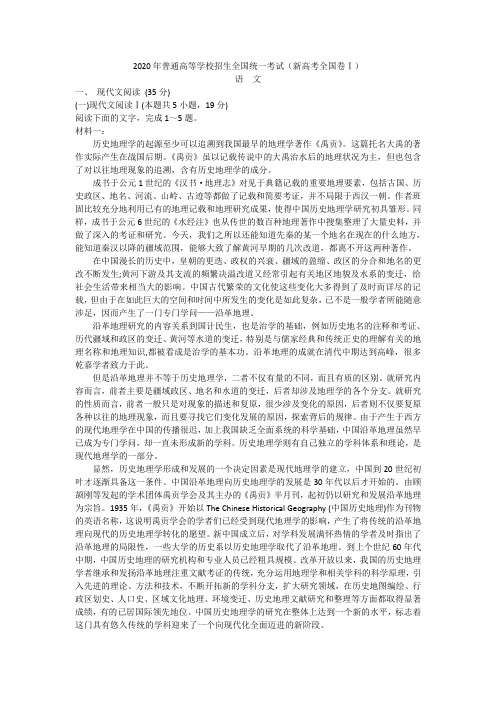
2020年普通高等学校招生全国统一考试(新高考全国卷Ⅰ)语文一、现代文阅读(35分)(一)现代文阅读Ⅰ(本题共5小题,19分)阅读下面的文字,完成1~5题。
材料一:历史地理学的起源至少可以追溯到我国最早的地理学著作《禹贡》。
这篇托名大禹的著作实际产生在战国后期。
《禹贡》虽以记载传说中的大禹治水后的地理状况为主,但也包含了对以往地理现象的追溯,含有历史地理学的成分。
成书于公元1世纪的《汉书·地理志》对见于典籍记载的重要地理要素,包括古国、历史政区、地名、河流、山岭、古迹等都做了记载和简要考证,并不局限于西汉一朝。
作者班固比较充分地利用已有的地理记载和地理研究成果,使得中国历史地理学研究初具雏形。
同样,成书于公元6世纪的《水经注》也从传世的数百种地理著作中搜集整理了大量史料,并做了深入的考证和研究。
今天,我们之所以还能知道先秦的某一个地名在现在的什么地方,能知道秦汉以降的疆域范围,能够大致了解黄河早期的几次改道,都离不开这两种著作。
在中国漫长的历史中,皇朝的更迭、政权的兴衰、疆域的盈缩、政区的分合和地名的更改不断发生;黄河下游及其支流的频繁决溢改道又经常引起有关地区地貌及水系的变迁,给社会生活带来相当大的影响。
中国古代繁荣的文化使这些变化大多得到了及时而详尽的记载,但由于在如此巨大的空间和时间中所发生的变化是如此复杂,已不是一般学者所能随意涉足,因而产生了一门专门学问——沿革地理。
沿革地理研究的内容关系到国计民生,也是治学的基础,例如历史地名的注释和考证、历代疆域和政区的变迁、黄河等水道的变迁,特别是与儒家经典和传统正史的理解有关的地理名称和地理知识,都被看成是治学的基本功。
沿革地理的成就在清代中期达到高峰,很多乾嘉学者致力于此。
但是沿革地理并不等于历史地理学,二者不仅有量的不同,而且有质的区别。
就研究内容而言,前者主要是疆域政区、地名和水道的变迁,后者却涉及地理学的各个分支。
就研究的性质而言,前者一般只是对现象的描述和复原,很少涉及变化的原因,后者则不仅要复原各种以往的地理现象,而且要寻找它们变化发展的原因,探索背后的规律。
2020年全国一卷阅读理解解析及译文

绝密★启用前2020年普通高等学校招生全国统一考试(全国卷I)英语注意事项:1. 答卷前,考生务必将自己的姓名、准考证号填写在答题卡和试卷指定位置上。
2. 回答选择题时,选出每小题答案后,用铅笔把答题卡上对应题目的答案标号涂黑。
如需改动,用橡皮擦干净后,再选涂其他答案标号。
回答非选择题时,将答案写在答题卡上,写在本试卷上无效。
3. 考试结束后,将本试卷和答题卡一并交回。
第二部分阅读理解(共两节,满分40分)第一节(共15小题;每小题2分,满分30分)阅读下列短文,从每题所给的A、B、C和D四个选项中,选出最佳选项。
ATrain InformationAll customers travelling on TransLink services must be in possession of a valid ticket before boarding. For ticket information,please ask at your local station or call 13 12 30.While Queensland Rail makes every effort to ensure trains run as scheduled,there can be no guarantee of connections between trains or between train services and bus services.Lost property(失物招领)Call Lost Property on 13 16 17 during business hours for items lost on Queensland Rail services.The lost property office is open Monday to Friday 7:30am to 5:00pm and is located(位于)at Roma Street station.Public holidaysOn public holidays, generally a Sunday timetable operates. On certain major event days,i.e.Australia Day, Anzac Day, sporting and cultural days, special additional services may operate.Christmas Day services operate to a Christmas Day timetable,Before travel please visit translink. com. au or call TransLink on 13 12 30 anytime.Customers using mobility devicesMany stations have wheelchair access from the car park or entrance to the station platforms.For assistance, please Queensland Rail on 13 16 17.Guardian trains (outbound)21. What would you do to get ticket information?A. Call 13 16 17.B. Visit .au.C. Ask at the local station.D. Check the train schedule.22. At which station can you find the lost property office?A. Altandi.B. Roma Street.C. Varsity Lakes.D. Fortitude Valley.23. Which train would you take if you go from Central to Varsity Lakes?A.6:42 pm.B.7:29 pm.C.8:57 pm.D.11:02 pm.B【1】Returning to a book you’ve read many times can feel like drinks with an old friend. There’s a welcome familiarity —but also sometimes a slight suspicion that time has changed you both, and thus the relationship. But books don’t change, people do. And tha t’s what makes the act of rereading so rich and transformative.【2】The beauty of rereading lies in the idea that our bond with the work is based on our present mental register. It’s true, the older I get, the more I feel time has wings. But with reading, i t’s all about the present. It’s about the now and what one contributes to the now, because reading is a give and take between author and reader. Each has to pull their own weight.【3】There are three books I reread annually. The first, which I take to reading every spring is Emest Hemningway’s A Moveable Feast. Published in 1964, it’s his classic memoir of 1920s Paris. The language is almost intoxicating (令人陶醉的),an aging writer looking back on an ambitious yet simpler time. Another is Annie Di llard’s Holy th e Firm, her poetic 1975 ramble (随笔) about everything and nothing. The third book is Julio Cortazar’s Save Twilight: Selected Poems, because poetry. And because Cortazar.【4】While I tend to buy a lot of books, these three were given to me as gifs, which might add to the meaning Iattach to them. But I imagine that, while money is indeed wonderful and necessary, rereading an author’s work is the highest currency a reader can pay them. The best books are the ones that open further as time passes. But remember, it’s you that has to grow and read and reread in order to better understand your friends.24. Why does the author like rereading?A. It evaluates the writer-reader relationship.B. It’s a w indow to a whole new world.C. It’s a substitute f or drinking with a friend.D. It extends the understanding of oneself.25. What do we know about the book A Moveable Feas!?A. It’s a brief account of a trip.B. It’s about Hemingway’s life as a young man.C. It’s a record of a historic event.D. It’s about Hemingway’s f riends in Paris.26. What does the underlined word "currency"in paragraph 4 refer to?A. DebtB. Reward.C. Allowance.D. Face value.27. What can we infer about the author from the text?A. He loves poetry.B. He’s an editor.C. He’s very ambitious.D. He teaches reading.C【1】Race walking shares many fitness benefits with running, research shows, while most likely contributing to fewer injuries. It does, however, have its own problem.【2】Race walkers are conditioned athletes. The longest track and field event at the Summer Olympics is the50-kilometer race wal k, which is about five miles longer than the marathon. But the sport’s rules require that a race walker’s knees stay straight through most o f the leg swing and one foot remain in contact (接触) with the ground at all times. It’s this strange form that makes race walking such an attractive activity, however, says Jaclyn Norberg, an assistant professor of exercise science at Salem State University in Salem, Mass.【3】Like running, race walking is physically demanding, she says, According to most calculations, race walkers moving at a pace of six miles per hour would burn about 800 calories(卡路里) per hour, which is approximately twice as many as they would burn walking, although fewer than running, which would probably burn about 1,000 or more calories per hour.【4】However, race walking does not pound the body as much as running does, Dr. Norberg says. According to her research, runners hit the ground with as much as four times their body weight per step, while race walkers, who do not leave the ground, create only about 1.4 times their body weight with each step.【5】As a result, she says, some of the injuries associated with running, such as runner’s knee, are uncommon among race walkers. But the sport’s strange form does place consider able stress on the ankles and hips, so people with a history of such injuries might want to be cautious in adopting the sport. In fact, anyone wishing to try race walking should probably first consult a coach or experienced racer to learn proper technique, she says. It takes some practice.28. Why are race walkers conditioned athletes?A. They must run long distances.B. They are qualified for the marathon.C. They have to follow special rules.D. They are good at swinging their legs.29. What advantage does race walking have over running?A. It’s more popular at the Olympics.B. It’s less challenging physically.C. It’s more effective in body building.D. It’s less likely to cause knee injuries.30 What is Dr. Norberg’s suggestion for someone trying race wa lking?A. Getting exp erts’ opinions.B. Having a medical checkup.C. Hiring an experienced coach.D. Doing regular exercises.31. Which word best describes the author’s attitude t o race walking?A. Skeptical.B. Objective.C. Tolerant.D. Conservative.D【1】The connection between people and plants has long been the subject of scientific research. Recent studies have found positive effects. A study conducted in Youngstown,Ohio,for example, discovered that greener areas of the city experienced less crime. In another,employees were shown to be 15% more productive when their workplaces were decorated with houseplants.【2】The engineers at the Massachusetts Institute of Technology(MIT)have taken it a step further changing the actual composition of plants in order to get them to perform diverse,even unusual functions. These include plants that have sensors printed onto their leaves to show when they’re short of water and a plant that can detect harmful chemicals in groundwater. "We’re thinking about how we can engi neer plants to replace functions of the things that we use every day,"explained Michael Strano, a professor of chemical engineering at MIT.【3】One of his latest projects has been to make plants grow(发光)in experiments using some common vegetables. Strano’s team found that they could create a faint light for three-and-a-half hours. The light,about one-thousandth of the amount needed to read by,is just a start. The technology, Strano said, could one day be used to light the rooms or even to turn tree into self-powered street lamps.【4】In the future,the team hopes to develop a version of the technology that can be sprayed onto plant leaves in a one-off treatment that would last the plant’s lifetime. The engineers are also trying to develop an on and off"switch"where the glow would fade when exposed to daylight.【5】Lighting accounts for about 7% of the total electricity consumed in the US. Since lighting is often far removed from the power source(电源)—such as the distance from a power plant to street lamps on a remote highway-a lot of energy is lost during transmission(传输). Glowing plants could reduce this distance and therefore help save energy.32. What is the first paragraph mainly about?A. A new study of different plants.B. A big fall in crime rates.C. Employees from various workplaces.D. Benefits from green plants.33. What is the function of the sensors printed on plant leaves by MIT engineer?A. To detect plants’ lack of waterB. To change compositions of plantsC. To make the life of plants longer.D. To test chemicals in plants.34. What can we expect of the glowing plants in the future?A. They will speed up energy production.B. They may transmit electricity to the home.C. They might help reduce energy consumption.D. They could take the place of power plants.35. Which of the following can be the best title for the text?A. Can we grow more glowing plants?B. How do we live with glowing plants?C. Could glowing plants replace lamps?D. How are glowing plants made pollution-free?【答案速查】21. C 22. B 23. B 24. D 25.B 26. B 27. A 28. C 29. D 30. A31.B 32. D 33.A 34. C 35. C【答案详解】A篇【A篇综述】3道阅读理解,定位简单,原词重复,为送分题,为这几年最简单1卷的A篇,感谢命题专家手下留情。
- 1、下载文档前请自行甄别文档内容的完整性,平台不提供额外的编辑、内容补充、找答案等附加服务。
- 2、"仅部分预览"的文档,不可在线预览部分如存在完整性等问题,可反馈申请退款(可完整预览的文档不适用该条件!)。
- 3、如文档侵犯您的权益,请联系客服反馈,我们会尽快为您处理(人工客服工作时间:9:00-18:30)。
2020高考全国卷阅读理解专项训练说明文六篇(生态环保类)1Sea ice is drifting(漂移) faster in the Arctic —which means polar bears need to walk farther to stay in their native range.Polar bears spend most of their time wandering the sea ice in search of seals. And seals spend most of their time underneath that ice, avoiding the top predator(捕食者). But climate change is giving polar bears additional challenges in their searches for food.“Sea ice is now drifting faster,” George Durner, a research zoologist said. He and colleagues compared sea ice conditions from 1987 to 1998 with those from 1999 to 2013. “And what we found was ice drift at the locations used by polar bears increased 30% in the Beaufort sea and 37% in the Chukchi sea.” That’s a problem because polar bears are homebodies — they prefer to stay in a specific range. “Throughout their range, they seem to have a sense of place. And here we have a situation where the general pattern of ice drift is westward, so to remain in their traditional range, it means they have to constantly be walking eastward to adapt to that westward drift.”The result: a large number of polar bears walk on the treadmill(跑步机). And all that walking requires extra fuel. On average, a single bear eats between 31 and 33 seals per year. But the changeable consequence of the treadmill effect means they have to eat on average one to three more. George Durner and some other scientists agree that increased Arctic sea ice drift makes adult female polar bears’ movements and energies change.And not only is the ice drifting faster, it’s also melting more, giving the bears less of the platform(平台). They use to pursue their prey. So they need more seals and will have a tougher time tracking them. All of this puts polar bears on a slippery slope. But maybe they keep expecting more trouble while growing up.32. What can we learn from Paragraph 3?A. George Durner collected the data by himself.B. Polar bears always change their living range.C. The research was carried out by making comparisons.D. Ice drift at the places where polar bears live increased by 7%.33. On average, how many seals does a bear eat at least half a year after climate change?A. 13.B. 16.C. 31.D. 32.34. How does the author find the polar bears’ situation?A. Interesting.B. Confusing.C. Surprising.D. Worrying.35. What does the passage mainly talk about?A. Ice is melting more and drifting faster.B. More seals are walking eastward.C. The polar bears prefer to 1ive in the same place.D. Climate change affects polar bears’ survival.2On July 10-12, 2017, a huge iceberg(冰山) named A-68 broke free from Antarctica’s Larsen C Ice Shelf. The crack(裂痕) that led to the separation was observable in 1963. However, the crack remained inactive for decades before suddenly spreading northwards and widening by 18 miles between 2011 and 2015 and then an additional 13 miles in 2016.Iceberg separation is not a natural part of a glacier’s(冰川) life cycle but a result of global warming. However, the separation of A-68 is receiving a lot of attention due to its size. Measuring 5,800 square kilometers, the A-68 has reduced the Larsen C Ice Shelf area by more than 12%.“The interesting thing is what happens next, how the remaining ice shelf responds,” said Kelly Brunt, who has studied the effects of the warming climate on the Larsen C Ice Shelf since 2015.“Many people may ask, ‘Will the ice shelf weaken? Or will it fall down, like its neighbors Larsen A and B? Will the glaciers behind the ice shelf speed up and have a direct contribution to sea level rise?’ I think answers may be not that terrible.”Ice shelves, which border 75% of the Antarctic Peninsula, form from snow that became ice thousands of years ago. They are found where glaciers meet the ocean and the weather is cold enough to keep the ice frozen. The icy structures are natural barriers against the water melting from glaciers, which can lead to rising sea levels.The Larsen Ice Shelf once consists of four parts: Larsen A (the smallest), Larsen B, Larsen C (the largest) and Larsen D. While scientists will continue to monitor A-68 and its parent, many believe it’ll take several years before Larsen C breaks down further. “The remaining 90% of the ice shelf continues to be held in place by two points,” said Chris Shuman, a glaciologist. “So I just don’t see any signs that this event will lead to the falling down of the Larsen C Ice Shelf. But we will be watching closely for signs of further changes.”28. Why did A-68 iceberg separation become a heated topic?A. Its effect was terrible.B. It was about global warming.C. Its size was very huge.D. It means a glacier’s life cycle.29. What is Kelly Brunt’s attitude towards the A-68 iceberg separation?A. Positive.B. Doubtful.C. Uninterested.D. Worried.30. Why are icy structures so important according to Paragraph 4?A. They help keep the weather cool.B. They help control the sea levels.C. They make water turn into the glaciers.D. They are necessary for scientists’ research.31. Chris Shuman thought that the A-68 iceberg separation would .A. influence the wildlife thereB. never change the icy structuresC. cause many further changesD. have little influence on Larsen C Ice Shelf3A ban on plastic bags came into force in Kenya on Monday in order to slow pollution. It means that the use, manufacture(制造) and importation of plastic bags will not be allowed in this country. The ban was first announced in February but it won't come into effect until six months from now when consumers and shopkeepers have adjusted to the new rules. However, some businessmen disagree with the ban, saying that jobs will be lost and that there will be difficulty earning a living.In Africa, a number of nations have already adopted or announced bans on plastic bags, including Rwanda and Morocco. But Kenya's new law is particularly tough, with fines of up to US $38,000 (about 253,000 yuan) and four-year prison sentences.In Kenya, about 100 million plastic bags are handed out each year by supermarkets alone. Plastic waste has long been associated with environmental damage and health risks, including killing wildlife, damaging agricultural land, polluting tourist sites and so on. Furthermore, plastic bags contribute to the more than eight million tons of plastics that enter the oceans each year.According to UN Environment, at current rates, by 2050 there will be more plastic in the oceans than fish, affecting wildlife and tourism seriously.Erik Solheim, Head of UN Environment, said: “Kenya is taking important action to remove an ugly stain on its outstanding natural beauty. Plastic waste also causes huge damage to ecosystems—both on land and at sea —and this decision is a huge and important step to ending plastic pollution.”Indonesia has promised to reduce marine waste by 70 percent within the next eight years, spending US $1 billion every year controlling waste products that pollute its oceans.Erik Solheim said: “ Kenya should be awarded for its environmental leadership. It's a great example that I hope will inspire others and help drive further commitments to the Clean Seas campaign.”28. What has Kenya decided to do?A. To help more people find jobs.B. To completely ban plastic bags.C. To stop importing goods made of plastic.D. To fine people who throw away rubbish.29. Compared to Rwanda and Morocco, Kenya’s new law ________.A. is much stricterB. will put more people into prisonC. can increase its government’s incomeD. can be more accessible to people30. What will happen in 2050, according to UN Environment?A. Plastic will be the most serious pollutant.B. More than eight million tons of plastics will be produced.C. There will be no land that is not polluted.D. There will be more plastic in the oceans than fish.31. What can we learn from Erik Solheim's words?A. Kenya's action deserves to be praised.B. Kenya will reduce its pollution by 70percent in six months.C. Kenya will soon end its plastic pollution thanks to the new law.D. Kenya is the leader in environmental protection in the world.4On June 19, 2015, more than a ton of ivory was crushed(碾碎) in New York City’s Times Square. The act is meant to help people know the threat of the illegal ivory trade to African elephants, and show the world that the illegal ivory trade cannot continue. The event was organized by the U.S. Fish and Wildlife Service, New York State agencies and the Wildlife Conservation Society, which runs New York City’s zoos. The crowd included lawmakers, wildlife supporters, and famous people.After speeches, a 25-ton rock crusher began crushing ivory. The hundreds of wildlife supporters began cheering as pieces of ivory flew from the machine.Wildlife activists say the act is important. The rate of elephant poaching(偷猎) has increased in recent years, largely as a result of increased demand for ivory. Because of the demand, elephant populations have dwindled. Fewer than 500,000 elephants live in Africa today, and poachers kill 50,000 each year.Destroying ivory that has been traded illegally may seem like a smart move, but the practice has received negative comments from a number of groups, including some wildlife supporters. They say that ivory contains evidence that could be used against traders. Others argue that crushing ivory reduces the supplies and increases the chances that poachers will hunt more elephants. But the groups behind the ivory crushing say the public understanding of this problem far outweighs the risks.After the act, Food Network star Katie Lee said, “I had no idea that the U.S. is one of the largest ivory markets in the world. Every time I tell someone the statistics, they’re shocked. The more people hear about this, the more changes can take place.”32. The act in New York City’s Times Square is meant to .A. show that the ivory trade is increasedB. tell people the harm of illegal poachingC. cheer lawmakers and wildlife supportersD. tell people that the illegal ivory market is to be crushed33. What does the underlined word “dwindled” in Paragraph 3 mean?A. Changed.B. Fallen.C. Grown.D. Increased.34. Paragraph 4 mainly shows that the act is .A. illegalB. negativeC. controversialD. important35. What does the author probably want to show by mentioning what Katie Lee said?A. The act is really shocking to many American people.B. The act can help bring more support to ivory protection.C. The U.S. is one of the largest ivory markets in the world.D. The illegal ivory trade will disappear in the U.S. one day.5Many animal species worldwide have become endangered. Here are some of the most endangered animals.Whooping craneIt is the tallest North American bird. In 1938, the first year when a population survey was done, only 29 whooping cranes remained in the wild. Three years later, only l6 were left. Hunting and the decrease of their habitats had harmed the population. Great efforts to save the birds did not begin until the late 1960s. Today, there are over 400 birds, thanks in large part to new breeding(繁殖) programs.Blue whaleThere are fewer than 25,000 blue whales, the largest animals on the planet. Blue whales are found in all of the world's oceans but the Arctic. Today their population has diminished by 90%because of humans’ hunting or killing blue whales in the 20th century. Hunting of the species for sale was forbidden in 1966. The National Marine Fisheries Service of the US explained a recovery plan in detail in 1998.Asian elephantThe best guess of IUCN (International Union for Conservation of Nature and Natural Resources) on today’s population of Asian elephants in 13 countries is around 40,000-50,000. That number may be far lower. Over 50% of the population is in India. The increasing human population there—and elsewhere in Asia—creates conflicts(冲突) for space and resources. And while the long teeth of Asian elephants are much smaller than those of African elephants, the Asian elephants are still killed for their ivory, meat, and skin.Snow leopard(雪豹)Though it’s called a leopard, the snow leopard is actually more closely related to the tiger. Probably fewer than 6,500 snow leopards remain in the wild. The largest populations are in Chinaand Mongolia, with large populations in India and Kyrgyzstan as well. The snow leopard usually hunts blue sheep as its food, but in some areas, it heavily depends on home-raised animals. The farmers who depend upon the animals shoot the “problem” leopards.28. What mainly helped the increase of whooping cranes’ population?A. The building of their habitats.B. The prevention of humans from hunting them.C. The programs that help them have young ones.D. The great efforts that aimed to save them before the 1960s.29. What does the underlined word “diminished” in Paragraph 3 mean?A. Decreased.B. Grown.C. Increased.D. Doubled.30. What problem do elephants in India face?A. They’re being driven to other Asian countries.B. Their ivory has become popular in recent years.C. Conflicts among people put them in danger.D. They are losing their habitats.31. Which of the following is a good way to help protect the snow leopard?A. Raising animals to feed them.B. Helping them live in different countries.C. Creating new breeding programs for them.D. Solving the conflicts between them and farmers.6From supermarket bags to CDs, man-made waste has polluted the entire globe, and become a very serious global problem. Recently, researchers may have found an unusual way to help solve the problem. A recent news article suggests that the waxworm(蜡虫), who eats beeswax as a food source, also appears to eat polyethylene, one of the strongest kinds of plastic.Researchers have described the tiny worm’s ability as "extremely exciting". Federica Bertocchini , a beekeeper, is with the Institute of Biomedicine and Biotechnology of Cantabria in Spain. She said she made the discovery after removing the waxworms from the beehives(蜂窝) where they live. She put the waxworms in a plastic shopping bag which became full of holes a few minutes later. Then Federica Bertocchini carried out many experiments on the waxworms. When 100 waxworms were placed in a normal British plastic shopping bag, the holes began to appear in just 40 minutes. Over a period of 12 hours, 92mg of plastic had been eaten.According to the researchers, a kind of enzyme(酶) produced by the waxworm is responsible for the process. They also found that the waxworm turns the plastic into a different thing. It is used in making a material for vehicles. It is not clear if the waxworm can produce a large number of such things. Plastic is not a kind of natural food for the waxworm. "Wax is a kind of natural plastic which is similar to polyethylene,” Federica Bertocchini said.Researchers say they still need to better understand how wax is digested(消化) in the waxworm. Federica Bertocchini said they would use the research to find a way to get rid of plastic waste. “ But we should not throw plastic bags into the environment, just because we now know how to break it down,” she added.28. What makes the waxworm special?A. Feeding on beeswax for a living.B. Causing a serious global problem.C. Being a kind of man-made insect.D. Helping break down a kind of plastic.29. What do the numbers mentioned in Paragraph 2 mainly show?A. The waxworm dislikes being put into a shopping bag.B. The waxworm bites the plastic bag in order to take a breath.C. The waxworm eats the plastic at extremely high speed.D. The waxworm spends 12 hours eating up a normal British plastic bag.30. What can we know about the waxworm from Paragraph 3?A. It can break down plastic because of a kind of enzyme.B. It can produce other kinds of enzyme.C. It can be used to make much money.D. It can eat all kinds of plastic.31. What will the researchers study next?A. How they can get rid of plastic waste.B. How wax is different from polyethylene.C. How wax is digested in the body of the waxworm.D. How they persuade people not to produce plastic waste.答案解析1【文章大意】本文是一篇说明文。
